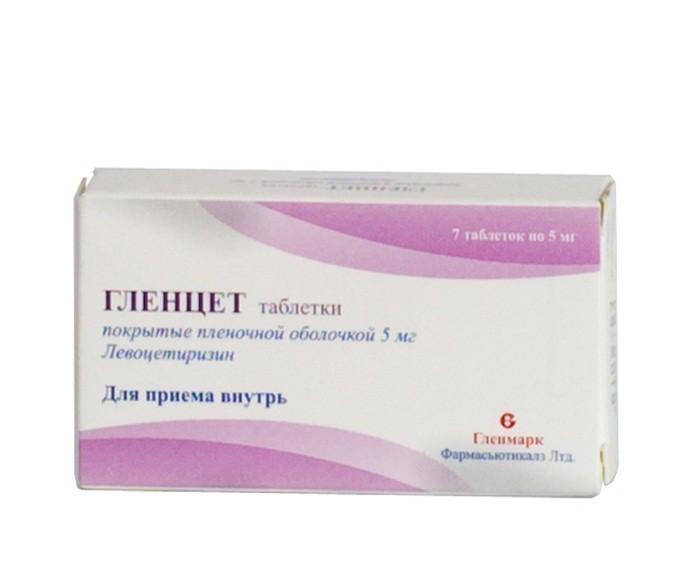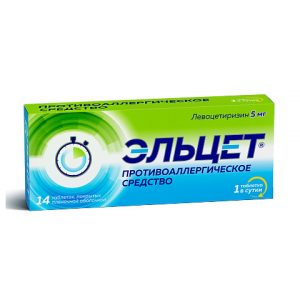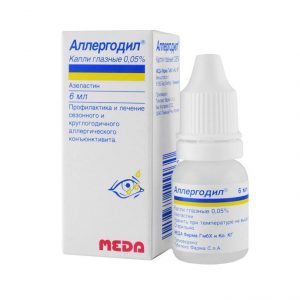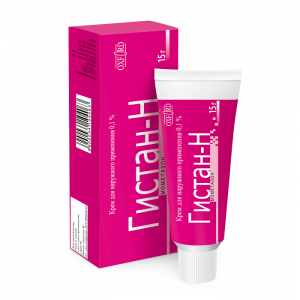Description
Release form
Film-coated tablets.
Packing
In a blister pack of 7 tablets. In a pack of cardboard 1 blister.
Pharmacological action of
GLENCET – levocetirizine – enantiomer of cetirizine:
– a competitive histamine antagonist
– blocks H1 -histamine
receptors – affinity for which is 2 times higher, than cetirizine
– has an effect on the histamine-dependent stage of allergic reactions
– reduces the migration of eosinophils
– vascular permeability of
– limits the release of inflammatory mediators
– prevents the development and facilitates the course of allergic anti-inflammatory
antiserotonin effect – in therapeutic doses, sedation is very mild.
Action begins 12 minutes after taking a single dose in 50% of patients, after 1 h in 95% of patients and lasts for 24 hours.
Indications
– symptomatic treatment of urticaria, incl. chronic idiopathic urticaria
– Quincke’s edema
– other allergic dermatoses, accompanied by itching and rashes.
Contraindications
Hypersensitivity (including to piperazine derivatives), severe chronic renal failure (CRF, CC less than 10 ml / min), pregnancy, lactation, children under 6 years of age.
galactose intolerance, lactase deficiency and glucose-galactose malabsorption.
Precautions
Chronic renal failure (dosage adjustment required), advanced age (possibly reduced glomerular filtration).
Special instructions
Caution is required while drinking with alcohol (see Interactions with Other Medicines).
Effect on the ability to drive vehicles and control mechanisms
With an objective assessment, the effect of the drug on the ability to drive vehicles and control mechanisms when taken at the recommended dose was not reliably noted.
Nevertheless, during the period of taking the drug, it is advisable to refrain from engaging in potentially hazardous activities that require an increased concentration of attention and speed of psychomotor reactions.
Composition
Core:
Levocetirizine dihydrochloride 5 mg hydrochloride – Lactose monohydrate (Tablettose 100)
Microcrystalline cellulose (Avitsel RN 112)
Colloidal silicon dioxide (Aerosil 200)
Magnesium stearate
Shell: white
White opadray (White Opadray Y-1-7osa-5gol diprom [hypoderm], giprom diprom [hypoderm, hygrome 400 (polyethylene oxide-400)]
Dosage and administration
Take orally, with food or on an empty stomach, with a little water, without chewing.
Recommended dose for adults and children over 6 years of age, elderly patients (subject to normal renal function) – 5 mg (1 tablet) once a day.
Inside, with food or on an empty stomach, washed down with a little water, without chewing.
Recommended dose for adults and children over 6 years of age, elderly patients (subject to normal renal function) – 5 mg (1 tablet) once a day.
In patients with chronic renal failure, the dose is halved (1 tablet every other day) with CC from 30 to 49 ml / min and 3 times (1 tablet in 3 days) with CC from 10 to 29 ml / min.
Dosage adjustment is not required for patients with hepatic insufficiency.
The course of treatment for chronic diseases is up to 18 months.
Side effects
Possible side effects are listed below for body systems and frequency of occurrence: often (> 1/10), infrequently (? 1/100,? 1/10), rarely (? 1/1000,? 1/100) , very rarely (? 1/10000,? 1/1000).
From the central nervous system
Infrequently: headache, fatigue, drowsiness.
Rarely: asthenia.
Very rarely: aggression, agitation, hallucinations, depression, convulsions. On the part of the sensory organs:
Very rarely: visual impairment.
From the digestive system:
Infrequently: dry oral mucosa.
Rarely: abdominal pain.
Very rare: nausea, diarrhea, hepatitis.
From the cardiovascular system:
Very rarely: tachycardia.
From the respiratory system: Very rarely: dyspnea.
From the musculoskeletal system:
Very rarely: myalgia. Metabolism:
Very rare: weight gain.
Laboratory findings:
Very rare: changes in liver function tests.
Allergic reactions:
Very rare: itching, rash, urticaria, angioedema, anaphylaxis.
Drug interaction
Theophylline (400 mg / day) reduces the total clearance of levocetirizine by 16%, while theophylline kinetics does not change.
Joint use with macrolides or ketoconazole did not cause significant changes on the ECG.
May enhance the effects of drugs that inhibit the central nervous system and ethanol.
Overdose
Symptoms:
drowsiness, in children – anxiety, irritability.
Treatment:
gastric lavage, activated charcoal, symptomatic therapy. There is no specific antidote. Hemodialysis is ineffective.
Storage conditions
Store in a dry, dark place at a temperature not exceeding 30 ° C.
Keep out of the reach and sight of children.
Shelf life
3 years.
Deystvuyushtee substance
levocetirizine
Dosage form
tablets
Appointment
Appointment
Children over 6 years old, for adults
Glenmark Farmasʹûtikalz Ltd, India




